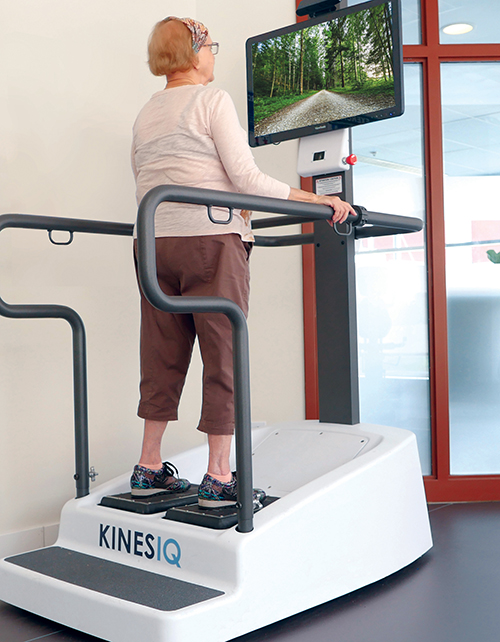Preserving functional autonomy with Kiné-Sim
KINE-SIM is a balance and motor skills exercise device that incorporates entertainment technologies. It is mainly designed for rehabilitation and the maintenance of functional autonomy and is available for follow-up care and rehabilitation services and senior residences in particular.

KINE-SIM uses simulation and virtual reality technology by incorporating a playful and interactive aspect. It is based on a continuously renewed offer of multisensory simulation of real-life scenarios that users can customise according to their interests.
The day before yesterday, I was skiing in the French Alps, this afternoon I think I’ll cross the Great Wall of China.
These scenarios are recreated by plates that faithfully reproduce the movements of each foot and are perfectly synchronised with multimedia content to ensure complete immersion.
The KINE-SIM is adapted to various pathologies: loss of independence, memory disorders, Parkinson’s disease, spinal cord injuries¹, cerebral palsy, strokes, multiple sclerosis, head trauma, musculoskeletal problems and amputees.
This is a real innovation for the Smart Care market, which involves several types of movements: multidirectional, unpredictable, rotational and much more!
In a safe and controlled environment, users reproduce daily life activities by adapting them at their own pace with the possibility of adjusting the speed, magnitude and desired level of difficulty.
¹ A spinal cord injury that results in total or partial paralysis of the limbs and trunk.
Weak signals: preventive tool for professionals and family members
In order to help professionals and family members to identify early signs of vulnerability in an elderly person, Telegrafik analyses their activity and constants over time and then detects any event or trend (weak signals) likely to indicate that they are becoming more vulnerable (sleep, social contact, health, etc.)
These weak signals can be detected on a daily, weekly or monthly basis and emailed to professional teams and/or authorised family members. Here are a few examples:
Number of abnormal nocturnal awakenings (sleep):
A notification is sent if the elderly person got up more times than usual during the night
Elderly person has not left the house for 48 to 72 hours (health, social contact):
A notification is sent if an elderly person who normally goes out on a regular basis has not left the house for at least 48 hoursh
Refrigerator has not been opened for 12 to 24 hours (health, nutrition) :
A notification is sent if the elderly person has not opened their fridge for a predefined number of hours (requires the refrigerator sensor option)

